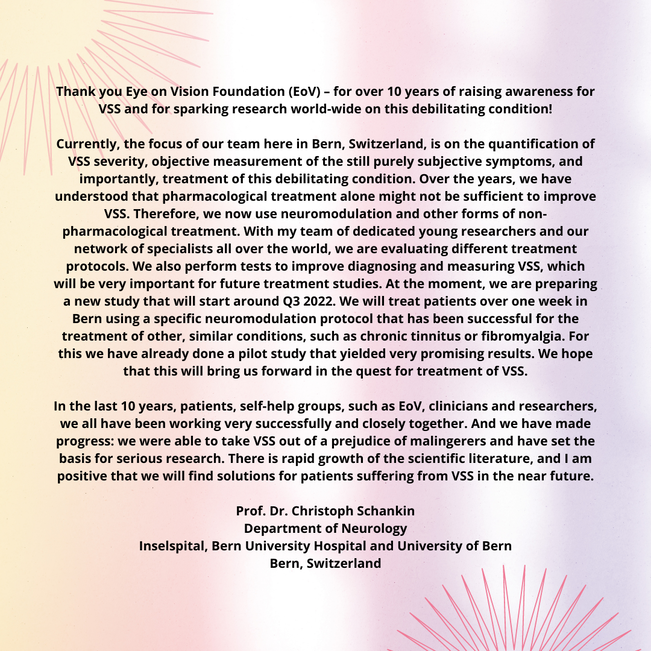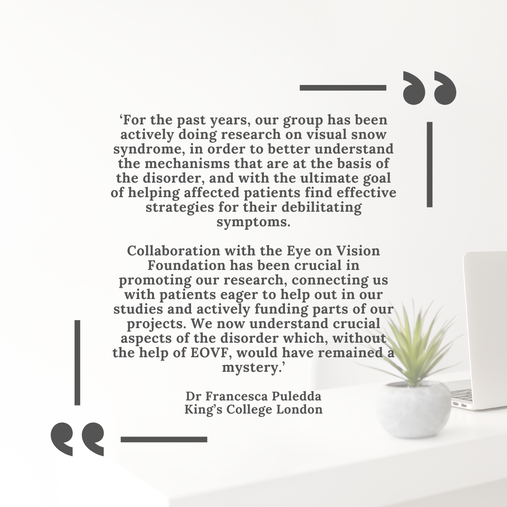|
Antonia Klein MD, Christoph J. Schankin MD First published: 27 September 2021 https://doi.org/10.1111/head.14213 Abstract Objective The aim of this narrative review is to explore the relationship between visual snow syndrome (VSS), migraine, and a group of other perceptual disorders. Background VSS is characterized by visual snow and additional visual and nonvisual disturbances. The clinical picture suggests a hypersensitivity to internal and external stimuli. Imaging and electrophysiological findings indicate a hyperexcitability of the primary and secondary visual areas of the brain possibly due to an impairment of inhibitory feedback mechanisms. Migraine is the most frequent comorbidity. Epidemiological and clinical studies indicate that other perceptual disorders, such as tinnitus, fibromyalgia, and dizziness, are associated with VSS. Clinical overlaps and parallels in pathophysiology might exist in relation to migraine. Methods We performed a PubMed and Google Scholar search with the following terms: visual snow syndrome, entoptic phenomenon, fibromyalgia, tinnitus, migraine, dizziness, persistent postural-perceptual dizziness (PPPD), comorbidities, symptoms, pathophysiology, thalamus, thalamocortical dysrhythmia, and salience network. Results VSS, fibromyalgia, tinnitus, and PPPD share evidence of a central disturbance in the processing of different stimuli (visual, somatosensory/pain, acoustic, and vestibular) that might lead to hypersensitivity. Imaging and electrophysiological findings hint toward network disorders involving the sensory networks and other large-scale networks involved in the management of attention and emotional processing. There are clinical and epidemiological overlaps between these disorders. Similarly, migraine exhibits a multisensory hypersensitivity even in the interictal state with fluctuation during the migraine cycle. All the described perceptual disorders are associated with migraine suggesting that having migraine, that is, a disorder of sensory processing, is a common link. Conclusion VSS, PPPD, fibromyalgia, and chronic tinnitus might lie on a spectrum of perceptual disorders with similar pathophysiological mechanisms and the common risk factor migraine. Understanding the underlying network disturbances might give insights into how to improve these currently very difficult to treat conditions. To view full article click here
Francesca Puledda, Muriel Bruchhage, Owen O'Daly, Dominic Ffytche, Steven C.R. Williams, Peter J. Goadsby First published August 5, 2020, DOI: https://doi.org/10.1212/WNL.0000000000010530 Abstract Objective To determine whether regional gray and white matter differences characterize the brain of patients with visual snow syndrome, a newly defined neurologic condition, we used a voxel-based morphometry approach. Methods In order to investigate whole brain morphology directly, we performed an MRI study on patients with visual snow syndrome (n = 24) and on age- and sex-matched healthy volunteers (n = 24). Voxel-based morphometry was used to determine volumetric differences in patients with visual snow. We further analyzed cerebellar anatomy directly using the high-resolution spatially unbiased atlas template of the cerebellum. Results Compared to healthy controls, patients with visual snow syndrome had increased gray matter volume in the left primary and secondary visual cortices, the left visual motion area V5, and the left cerebellar crus I/lobule VI area. These anatomical alterations could not be explained by clinical features of the condition. Conclusion Patients with visual snow syndrome have subtle, significant neuroanatomical differences in key visual and lateral cerebellar areas, which may in part explain the pathophysiologic basis of the disorder. To access the full article please download the PDF below or download here
Disrupted connectivity within visual, attentional and salience networks in the visual snow syndrome1/4/2022
Francesca Puledda, Owen O'Daly, Christoph Schankin, Dominic Ffytche, Steven CR Williams, Peter J Goadsby First published: 15 January 2021 https://doi.org/10.1002/hbm.25343 Abstract Here we investigate brain functional connectivity in patients with visual snow syndrome (VSS). Our main objective was to understand more about the underlying pathophysiology of this neurological syndrome. Twenty-four patients with VSS and an equal number of gender and age-matched healthy volunteers attended MRI sessions in which whole-brain maps of functional connectivity were acquired under two conditions: at rest while watching a blank screen and during a visual paradigm consisting of a visual-snow like stimulus. Eight unilateral seed regions were selected a priori based on previous observations and hypotheses; four seeds were placed in key anatomical areas of the visual pathways and the remaining were derived from a pre-existing functional analysis. The between-group analysis showed that patients with VSS had hyper and hypoconnectivity between key visual areas and the rest of the brain, both in the resting state and during a visual stimulation, compared with controls. We found altered connectivity internally within the visual network; between the thalamus/basal ganglia and the lingual gyrus; between the visual motion network and both the default mode and attentional networks. Further, patients with VSS presented decreased connectivity during external sensory input within the salience network, and between V5 and precuneus. Our results suggest that VSS is characterised by a widespread disturbance in the functional connectivity of several brain systems. This dysfunction involves the pre-cortical and cortical visual pathways, the visual motion network, the attentional networks and finally the salience network; further, it represents evidence of ongoing alterations both at rest and during visual stimulus processing. Please click here to read full article
Christoph J. Schankin, Farooq H. Maniyar, Kathleen B. Digre, Peter J. Goadsby Brain, Volume 137, Issue 5, May 2014, Pages 1419–1428, https://doi.org/10.1093/brain/awu050 Published:18 March 2014 Abstract Patients with ‘visual snow’ report continuous tiny dots in the entire visual field similar to the noise of an analogue television. As they frequently have migraine as a comorbidity with ophthalmological, neurological and radiological studies being normal, they are offered various diagnoses, including persistent migraine aura, post-hallucinogen flashback, or psychogenic disorder. Our aim was to study patients with ‘visual snow’ to characterize the phenotype. A three-step approach was followed: (i) a chart review of patients referred to us identified 22 patients with ‘visual snow’. Fifteen had additional visual symptoms, and 20 patients had comorbid migraine, five with aura; (ii) to identify systematically additional visual symptoms, an internet survey (n = 275) of self-assessed ‘visual snow’ subjects done by Eye On Vision Foundation was analysed. In two random samples from 235 complete data sets, the same eight additional visual symptoms were present in >33% of patients: palinopsia (trailing and afterimages), entoptic phenomena (floaters, blue field entoptic phenomenon, spontaneous photopsia, self-light of the eye), photophobia, and nyctalopia (impaired night vision); and (iii) a prospective semi-structured telephone interview in a further 142 patients identified 78 (41 female) with confirmed ‘visual snow’ and normal ophthalmological exams. Of these, 72 had at least three of the additional visual symptoms from step (ii). One-quarter of patients had ‘visual snow’ as long as they could remember, whereas for the others the mean age of onset was 21 ± 9 years. Thirty-two patients had constant visual symptoms, whereas the remainder experienced either progressive or stepwise worsening. Headache was the most frequent symptom associated with the beginning or a worsening of the visual disturbance (36%), whereas migraine aura (seven patients) and consumption of illicit drugs (five, no hallucinogens) were rare. Migraine (59%), migraine with aura (27%), anxiety and depression were common comorbidities over time. Eight patients had first degree relatives with visual snow. Clinical investigations were not contributory. Only a few treatment trials have been successful in individual patients. Our data suggest that ‘visual snow’ is a unique visual disturbance clinically distinct from migraine aura that can be disabling for patients. Migraine is a common concomitant although standard migraine treatments are often unhelpful. ‘Visual snow’ should be considered a distinct disorder and systematic studies of its clinical features, biology and treatment responses need to be commenced to begin to understand what has been an almost completely ignored problem. To read the full article please click here or download the PDF below
M. Viana, F. Puledda, P. J. Goadsby First published: 01 June 2020 https://doi.org/10.1111/ene.14369 Abstract Background and purpose Visual snow manifests as a pan-field, dynamic visual disturbance described as continuous television static-like tiny flickering dots. Current diagnostic criteria further require at least two additional symptoms for visual snow syndrome (VSS) from: palinopsia (afterimages and trailing); entoptic phenomena (floaters, blue field entoptic phenomenon, photopsia, self-light of the eye); photophobia and nyctalopia. Our objective was to compare the phenotype of VSS in an Italian and British population. Methods Patients with VSS were characterized clinically using the current criteria. An online survey was prepared in collaboration with the patient group Eye-on-Vision. Patients were directed to the site if they contacted us by email asking to be involved in research. After data collection, we compared the phenotypic characteristics of a subgroup of British versus Italian patients taking part in the survey. As we expected more responses from the UK, we matched 100 UK patients for gender and age with our Italian cohort. Results Patients were enrolled from the UK (n = 100) and Italy (n = 100). The populations had similar demography. After multiple correction testing there were no differences in VSS features between the two groups. The same was true for the prevalence of migraine and previous use of recreational drugs. Conclusion This is the first study comparing the phenotype of VSS between two distinct populations. Our findings suggest that the visual snow phenotype, as well as migraine comorbidity, is similar across the two groups. To read full article please click here or download the PDF below
Francesca Puledda, Dominic Ffytche, David J. Lythgoe, Owen O’Daly, Christoph Schankin, Steven C. R. Williams, Peter J. Goadsby First published: 10 March 2020 https://doi.org/10.1002/acn3.50986 Objective To investigate the pathophysiology of visual snow (VS), through a combined functional neuroimaging and magnetic resonance spectroscopy (1H-MRS) approach. Methods We applied a functional MRI block-design protocol studying the responses to a visual stimulation mimicking VS, in combination with 1H-MRS over the right lingual gyrus, in 24 patients with VS compared to an equal number of age- and gender-matched healthy controls. Results We found reduced BOLD responses to the visual stimulus with respect to baseline in VS patients compared to controls, in the left (k = 291; P = 0.025; peak MNI coordinate [-34 12 -6]) and right (k = 100; P = 0.003; peak MNI coordinate [44 14 -2]) anterior insula. Our spectroscopy analysis revealed a significant increase in lactate concentrations in patients with respect to controls (0.66 ± 0.9 mmol/L vs. 0.07 ± 0.2 mmol/L; P < 0.001) in the right lingual gyrus. In this area, there was a significant negative correlation between lactate concentrations and BOLD responses to visual stimulation (P = 0.004; r = −0.42), which was dependent on belonging to the patient group. Interpretation As shown by our BOLD analysis, VS is characterized by a difference in bilateral insular responses to a visual stimulus mimicking VS itself, which could be due to disruptions within the salience network. Our results also suggest that patients with VS have a localized disturbance in extrastriate anaerobic metabolism, which may in turn cause a decreased metabolic reserve for the regular processing of visual stimuli. For full article please click here or download the PDF below
Christoph J. Schankin MD, Farooq H. Maniyar MD, Till Sprenger MD, Denise E. Chou MD, Michael Eller MD, Peter J. Goadsby MD, PhD First published: 09 May 2014 https://doi.org/10.1111/head.12378 Objective To assess the relationship between the phenotype of the “visual snow” syndrome, comorbid migraine, and typical migraine aura on a clinical basis and using functional brain imaging. Results (1) Of 120 patients with “visual snow,” 70 patients also had migraine and 37 had typical migraine aura. Having comorbid migraine was associated with an increased likelihood of having palinopsia (odds ratio [OR] 2.8; P = .04 for “afterimages” and OR 2.6; P = .01 for “trailing”), spontaneous photopsia (OR 2.9; P = .004), photophobia (OR 3.2; P = .005), nyctalopia (OR 2.7; P = .01), and tinnitus (OR 2.9; P = .006). Typical migraine aura was associated with an increased likelihood of spontaneous photopsia (OR 2.4; P = .04). (2) After adjusting for typical migraine aura, comparison of 17 “visual snow” patients with 17 age and gender matched controls showed brain hypermetabolism in the right lingual gyrus (Montreal Neurological Institute coordinates 16-78-5; kE = 101; ZE = 3.41; P < .001) and the left cerebellar anterior lobe adjacent to the left lingual gyrus (Montreal Neurological Institute coordinates -12-62-9; kE = 152; ZE = 3.28; P = .001). Conclusions Comorbid migraine aggravates the clinical phenotype of the “visual snow” syndrome by worsening some of the additional visual symptoms and tinnitus. This might bias studies on “visual snow” by migraineurs offering study participation more likely than non-migraineurs due to a more severe clinical presentation. The independence of entoptic phenomena from comorbid migraine indicates “visual snow” is the main determinant. The hypermetabolic lingual gyrus confirms a brain dysfunction in patients with “visual snow.” The metabolic pattern differs from interictal migraine with some similarities to migrainous photophobia. The findings support the view that “visual snow,” migraine, and typical migraine aura are distinct syndromes with shared pathophysiological mechanisms that need to be addressed in order to develop rational treatment strategies for this disabling condition. Click here to read the entire article or download the PDF below
Ozan Eren, Christoph J Schankin First Published May 20, 2020 Research Article https://doi.org/10.1177/2514183X20925695 Results:Mirtazapine has no effect on VSS, neither positive nor negative. This is in line with the reports from the literature suggested only some beneficial effects from lamotrigine. Conclusions:Since the pathophysiology of VSS is not fully understood, we still rely on the reports of individual cases or patient series. This includes not only the positive, but also the negative results to avoid unnecessary treatment trials. Looking into the literature, antidepressants do not seem to be a solution for the visual symptoms. So far, best data exists for the anticonvulsant lamotrigine. Click here to read full article or download the PDF below
|
Eye On Vision FoundationCollaborating with and funding researchers since 2006. Archives
November 2023
Categories |
||||||||||||||||||||||||||||||||||||||||||
Photo from shixart1985



 RSS Feed
RSS Feed
